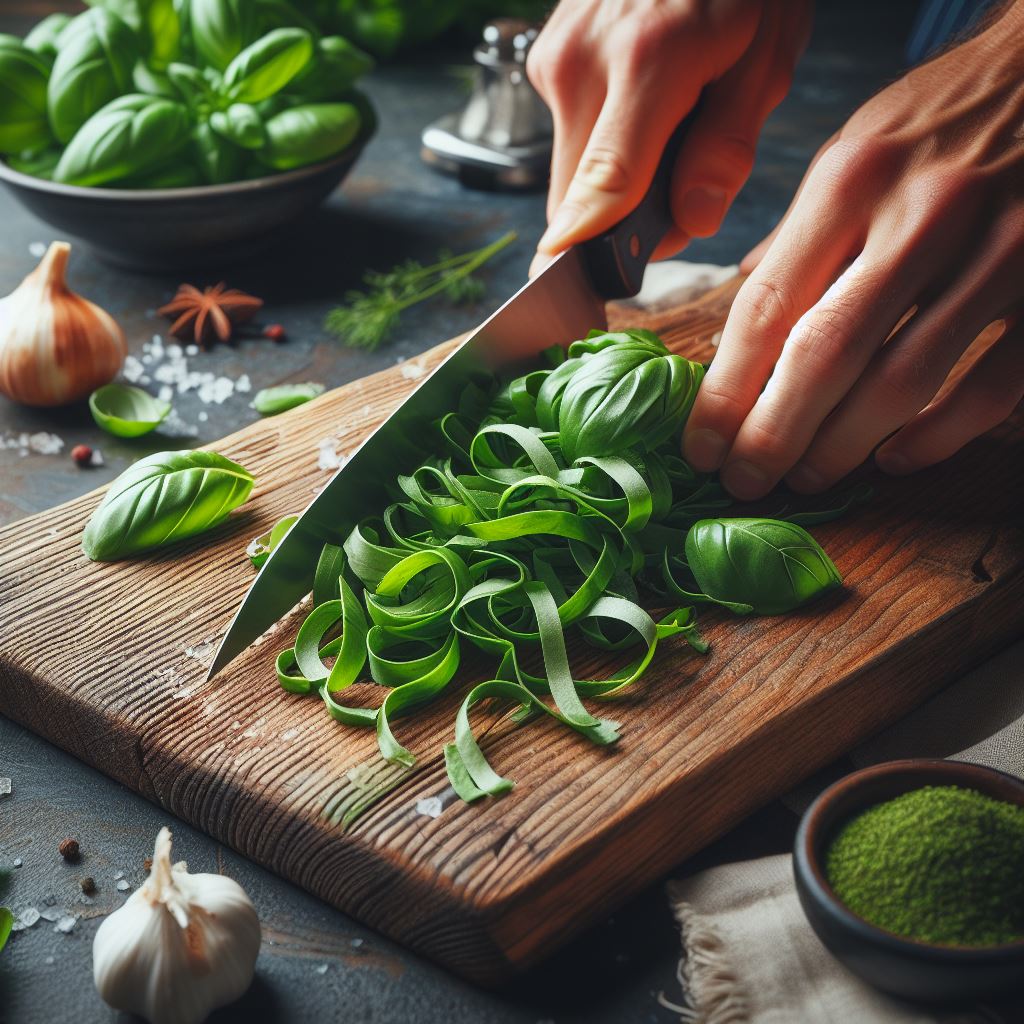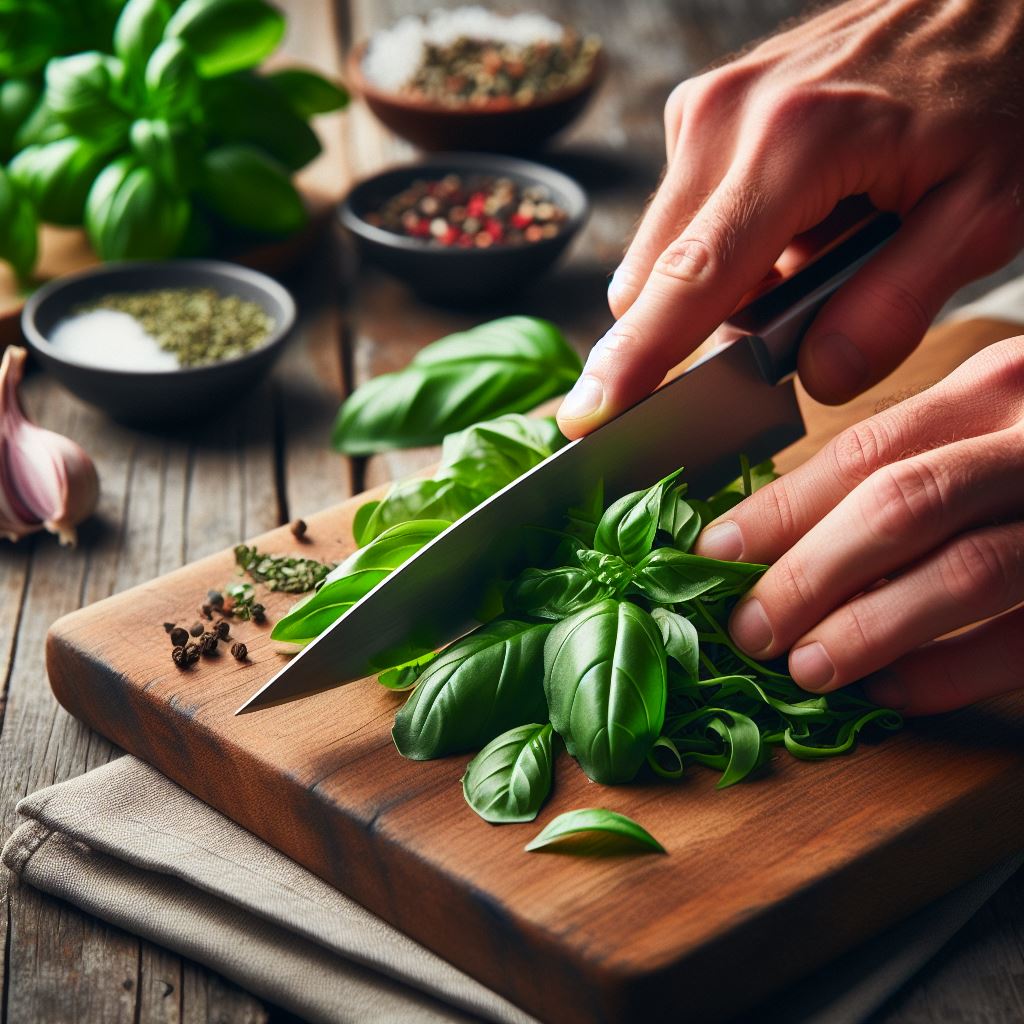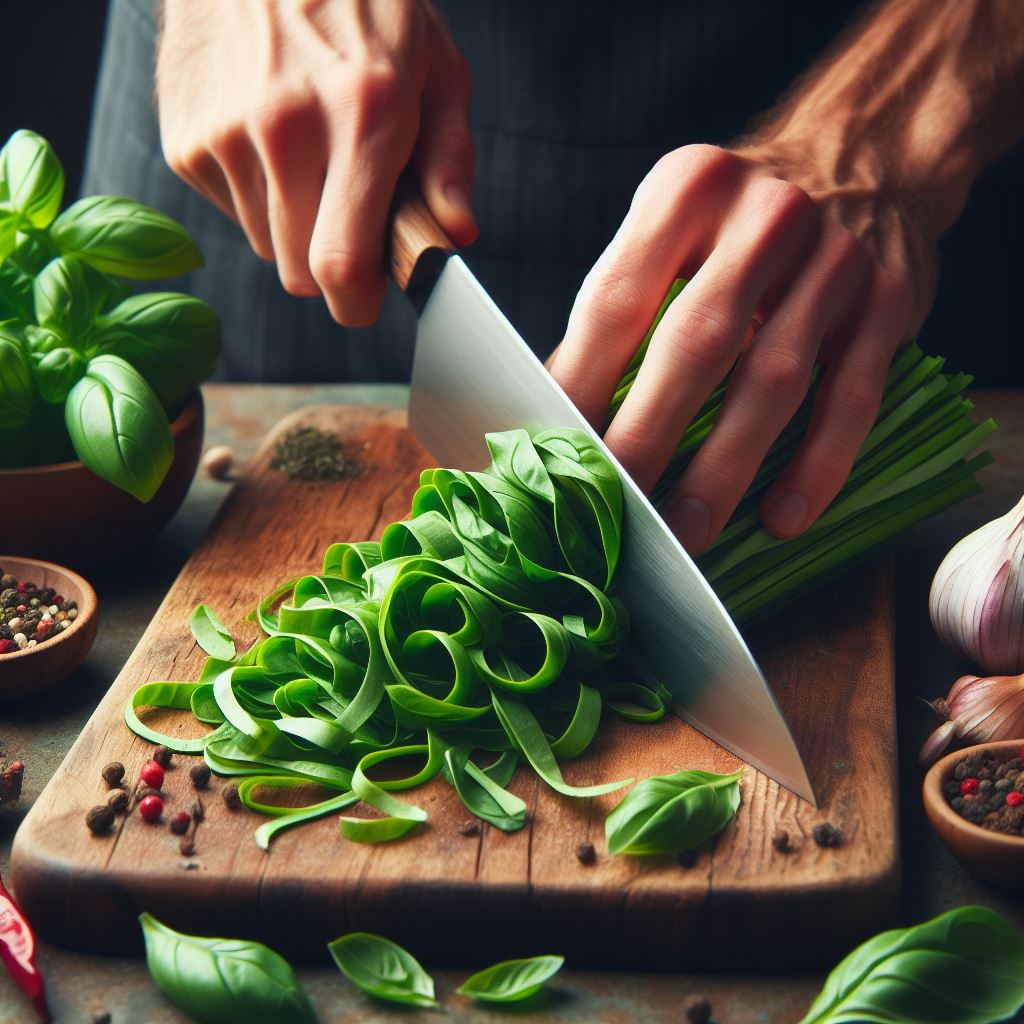A chiffonade cut typically results in thin strips or ribbons about 1/8 to 1/16 inch wide. This technique is commonly used for leafy herbs and vegetables.
Mastering the chiffonade cut enhances the visual appeal and texture of dishes. It’s a fundamental skill that home cooks and professional chefs alike employ to prepare ingredients like basil, mint, spinach, and other leafy greens. Chiffonade, meaning “made of rags” in French, implies the fabric-like strips you create by rolling leaves tightly and slicing them thinly.
This technique not only adds finesse to garnishes but also ensures even distribution of flavors. Achieving the perfect chiffonade requires a sharp knife and a delicate hand, ensuring the greens are not bruised during the process. Incorporating skillful chiffonade cuts into your culinary repertoire can elevate salads, soups, and pasta dishes.

If you’ve ever admired the delicate ribbons of basil atop a beautifully plated dish, you’ve witnessed the art of the chiffonade cut. This slicing technique turns leafy herbs and greens into elegant, slender strips, adding both visual appeal and distributed flavor to dishes. Dive into the world of chiffonade to enhance your culinary presentation and flavor delivery.
Defining Chiffonade: A Culinary Technique
The term chiffonade translates to ‘made of rags’ in French, which aptly describes the fabric-like strips that this method produces. Primarily used for leafy vegetables and herbs such as basil, mint, and spinach, the chiffonade cut is executed by stacking leaves, rolling them tightly, and then slicing them perpendicularly to create thin ribbons. This technique not only adds a professional touch to dishes but also ensures the even integration of herbs throughout the culinary creation.
Historical Background And Culinary Significance
Chiffonade cuts have their roots deep in French culinary tradition, emerging as a refined skill among chefs who value precise and decorative garnishes. The history of the chiffonade underscores the evolution of gastronomy, emphasizing not just flavor but also the aesthetics of food. The significance of chiffonade in cooking is twofold: it elevates the visual element of plating while also unlocking the aromatic potential of fresh herbs, allowing them to release their full spectrum of flavors when delicately intertwined with other ingredients.
Executing The Chiffonade Cut
There’s an art to elegant food presentation, and mastering the chiffonade cut can elevate your culinary creations from good to gourmet. But before you start rolling and slicing, understanding the technique is key for delicate, even ribbons of greens and herbs.
Choosing The Right Ingredients For Chiffonade
Not all leaves are created equal, and some are just better suited for a chiffonade. When selecting, look for fresh, firm leaves such as basil, mint, or spinach—they should be resilient and not prone to bruising. Whether accenting a dish or contributing to a flavor profile, the right ingredient makes all the difference.
Step-by-step Guide To Achieving The Perfect Chiffonade Cut
To achieve those beautiful, thin strips, follow this simple guide:
- Wash and dry the leaves thoroughly. Excess moisture can cause slipping and uneven cuts.
- Stack the leaves on top of each other, aligning the edges carefully.
- Roll them tightly into a cigar shape—this technique is key for compact slicing.
- Using a sharp knife, slice perpendicular to the roll, creating thin ribbons. A precise, sawing motion limits bruising.
- Gently separate the ribbons with your fingers to prevent clumping.
This method ensures consistent, delicate strips perfect for garnishing or incorporating into dishes.
Common Mistakes To Avoid When Chiffonading
- Avoid using dull knives which can bruise and crush the leaves, diminishing their appearance and flavor.
- Don’t rush the process. Speed can lead to uneven cuts and potential injury.
- Overstacking leaves can make the roll too bulky; aim for a moderate amount for easier slicing.
- Neglecting to line up edges before rolling results in irregular sizes, compromising the final presentation.
Remember, the chiffonade cut is as much about technique as it is about care. Take your time, and watch as your dishes transform with these delicate touches of greens.
Applications And Variations Of Chiffonade Cut Size
Delving into the art of fine chopping, the chiffonade cut is a testament to a chef’s knife skills and precision. This technique, not only adds visual appeal with its delicate ribbons but also distributes flavors more evenly through a dish. The chiffonade cut size plays a pivotal role in its applications—ranging from garnishes to integrating herbs seamlessly into dishes. Let’s slice through the details of utilizing chiffonade cuts to enhance culinary presentation and explore the variations that align perfectly with different culinary uses.
Standard Chiffonade Size And Its Uses In Culinary Presentation
The standard chiffonade cut, typically about 1/8 inch in width, is achieved by stacking leaves, rolling them tightly, and then slicing them into thin strips. Its uses are as varied as they are impressive, often seen adorning soups, pasta dishes, and salads.
- Garnishing: Sprinkling a chiffonade of basil atop a Margherita pizza for a fresh, herbaceous finish.
- Infusing Flavors: Incorporating a chiffonade of mint into iced teas or cocktails for a burst of cool, aromatic flavor.
- Enhancing Texture: Adding a chiffonade of spinach to omelets for a delicate yet distinctive bite.

Variations In Size For Different Culinary Applications
Moving beyond the standard, culinary professionals may adjust the chiffonade cut size to complement the dish’s texture and aesthetic. For coarser or more rustic presentations, a wider cut may be used, while finer dishes may call for a more delicate chiffonade.
| Chiffonade Size | Application |
|---|---|
| Fine Chiffonade (1/16 inch) | Perfect for lighter dishes where a subtle herb presence is desired. |
| Medium Chiffonade (1/8 inch) | Ideal for garnishes and integrating herbs into salads and entrees. |
| Broad Chiffonade (1/4 inch) | Suitable for dishes that demand a bolder herbaceous statement. |
Innovative Dishes Featuring Chiffonade Cut Techniques
The versatility of the chiffonade cut paves the way for creative culinary innovations. Here, the technique transcends mere aesthetics, playing a central role in the dish’s composition and enjoyment.
- Herb-Infused Ice Creams: A fine chiffonade of basil blended into sweet cream bases for a refreshing twist.
- Deconstructed Pesto Pastas: Medium-size chiffonade of basil mixed with toasted pine nuts, garlic, and Parmesan, tossed with al dente pasta.
- Asian Fusion Tacos: Broad chiffonade of Thai basil used as a punchy counterpoint in flavor-packed tacos.
Maintenance Of Skills And Tools For Chiffonade
Welcome to the delicate world of chiffonade, a cutting technique cherished by chefs for adding sophistication to plates with fine ribbons of herbs or leafy vegetables. Maintaining skills and tools for the perfect chiffonade is essential for both the professional kitchen and the avid home cook. Precision, consistency, and sharp tools are the cornerstone of this elegant culinary skill.
Selecting And Caring For Knives Suitable For Chiffonade
Choosing the right knife is pivotal for achieving the perfect chiffonade. A sharp, high-quality chef’s knife or paring knife ensures control and precision. Here are steps for selecting and maintaining the ideal knife:
- Knife Selection: Opt for a knife with a comfortable grip and a blade that’s approximately 8 inches long.
- Cleaning: Clean knives immediately after use with warm water and mild detergent. Dry thoroughly.
- Storage: Store knives in a block or on a magnetic strip away from other utensils.
- Regular Maintenance: Hone with a steel rod every few uses to maintain the edge.
Sharpening Skills: Consistency In Chiffonade Cut Size
Consistency in chiffonade cut size is not only visually appealing but also ensures even cooking and texture. Sharpening your knife regularly is key to maintaining the ability to perform precise cuts. Here’s how to keep your knife and skills sharp for that consistently perfect chiffonade:
- Sharpening Frequency: Sharpen your knife every few months or when you notice it is becoming dull.
- Sharpening Tools: Use a whetstone or a knife sharpener designed for your specific blade.
- Sharpening Technique: Maintain a 20-degree angle between the knife and the stone for an optimal edge.
- Practice: Regularly practice your cutting technique. Consistency comes with repetition.
Advanced Techniques And Continuing Education For Professional Chefs
Professional chefs understand the need for continuous learning. Advanced techniques in knife skills, such as the chiffonade, are often a part of a broader culinary education. Explore these opportunities to refine your chiffonade and other culinary skills:
- Culinary Workshops: Attend workshops that focus specifically on knife skills.
- Online Courses: Engage in online classes offering in-depth lessons on advanced cutting techniques.
- Peer Learning: Learn from peers by observing and asking questions to pick up new skills and tricks.
- Experimentation: Experiment with different ingredients and challenge yourself with various cutting styles.

Conclusion
Mastering the chiffonade technique elevates your culinary artistry, infusing dishes with delicate beauty. Perfect for herbs and leafy greens, it adds both flavor and finesse. Embrace this simple yet effective cut to transform your presentations with a touch of gourmet elegance.
Remember, practice makes perfect. Happy chopping!







